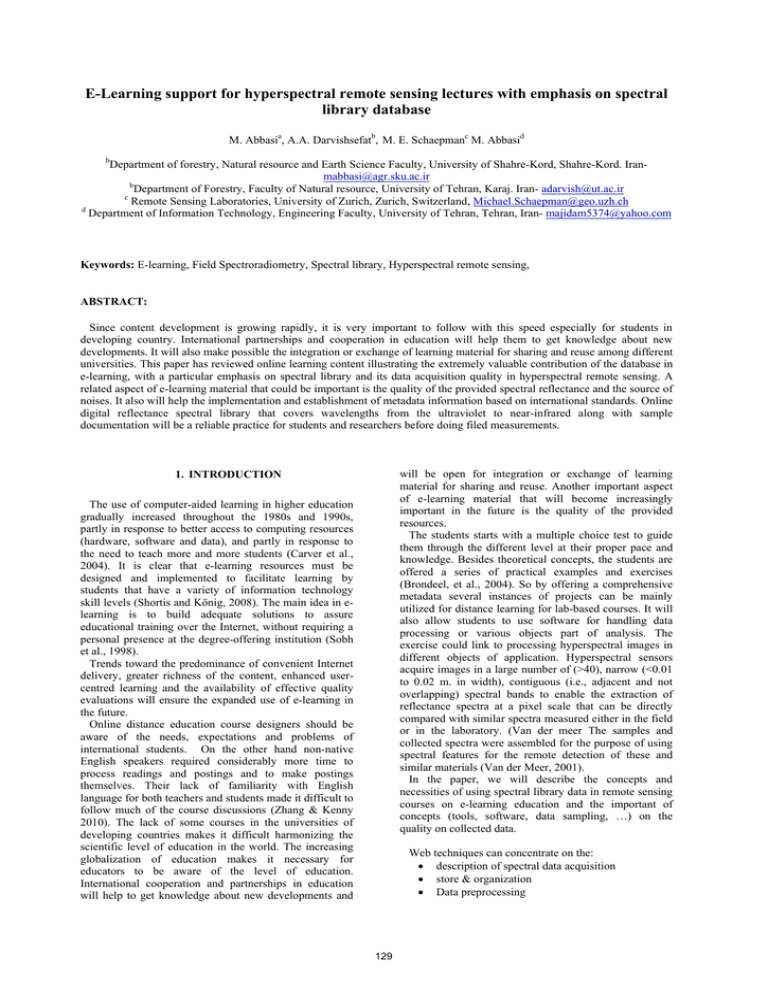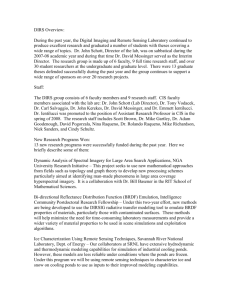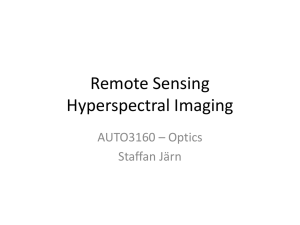E-Learning support for hyperspectral remote sensing lectures with emphasis on... library database
advertisement

E-Learning support for hyperspectral remote sensing lectures with emphasis on spectral library database M. Abbasia, A.A. Darvishsefatb, M. E. Schaepmanc M. Abbasid b Department of forestry, Natural resource and Earth Science Faculty, University of Shahre-Kord, Shahre-Kord. Iranmabbasi@agr.sku.ac.ir b Department of Forestry, Faculty of Natural resource, University of Tehran, Karaj. Iran- adarvish@ut.ac.ir c Remote Sensing Laboratories, University of Zurich, Zurich, Switzerland, Michael.Schaepman@geo.uzh.ch d Department of Information Technology, Engineering Faculty, University of Tehran, Tehran, Iran- majidam5374@yahoo.com Keywords: E-learning, Field Spectroradiometry, Spectral library, Hyperspectral remote sensing, ABSTRACT: Since content development is growing rapidly, it is very important to follow with this speed especially for students in developing country. International partnerships and cooperation in education will help them to get knowledge about new developments. It will also make possible the integration or exchange of learning material for sharing and reuse among different universities. This paper has reviewed online learning content illustrating the extremely valuable contribution of the database in e-learning, with a particular emphasis on spectral library and its data acquisition quality in hyperspectral remote sensing. A related aspect of e-learning material that could be important is the quality of the provided spectral reflectance and the source of noises. It also will help the implementation and establishment of metadata information based on international standards. Online digital reflectance spectral library that covers wavelengths from the ultraviolet to near-infrared along with sample documentation will be a reliable practice for students and researchers before doing filed measurements. will be open for integration or exchange of learning material for sharing and reuse. Another important aspect of e-learning material that will become increasingly important in the future is the quality of the provided resources. The students starts with a multiple choice test to guide them through the different level at their proper pace and knowledge. Besides theoretical concepts, the students are offered a series of practical examples and exercises (Brondeel, et al., 2004). So by offering a comprehensive metadata several instances of projects can be mainly utilized for distance learning for lab-based courses. It will also allow students to use software for handling data processing or various objects part of analysis. The exercise could link to processing hyperspectral images in different objects of application. Hyperspectral sensors acquire images in a large number of (>40), narrow (<0.01 to 0.02 m. in width), contiguous (i.e., adjacent and not overlapping) spectral bands to enable the extraction of reflectance spectra at a pixel scale that can be directly compared with similar spectra measured either in the field or in the laboratory. (Van der meer The samples and collected spectra were assembled for the purpose of using spectral features for the remote detection of these and similar materials (Van der Meer, 2001). In the paper, we will describe the concepts and necessities of using spectral library data in remote sensing courses on e-learning education and the important of concepts (tools, software, data sampling, …) on the quality on collected data. 1. INTRODUCTION The use of computer-aided learning in higher education gradually increased throughout the 1980s and 1990s, partly in response to better access to computing resources (hardware, software and data), and partly in response to the need to teach more and more students (Carver et al., 2004). It is clear that e-learning resources must be designed and implemented to facilitate learning by students that have a variety of information technology skill levels (Shortis and König, 2008). The main idea in elearning is to build adequate solutions to assure educational training over the Internet, without requiring a personal presence at the degree-offering institution (Sobh et al., 1998). Trends toward the predominance of convenient Internet delivery, greater richness of the content, enhanced usercentred learning and the availability of effective quality evaluations will ensure the expanded use of e-learning in the future. Online distance education course designers should be aware of the needs, expectations and problems of international students. On the other hand non-native English speakers required considerably more time to process readings and postings and to make postings themselves. Their lack of familiarity with English language for both teachers and students made it difficult to follow much of the course discussions (Zhang & Kenny 2010). The lack of some courses in the universities of developing countries makes it difficult harmonizing the scientific level of education in the world. The increasing globalization of education makes it necessary for educators to be aware of the level of education. International cooperation and partnerships in education will help to get knowledge about new developments and Web techniques can concentrate on the: description of spectral data acquisition store & organization Data preprocessing 129 Data analysis (Vegetation index, data transformation, statistical analysis, ...) Using the spectral data in remote sensing images presentation and web-interface design 1 0.9 Water absorption features 0.8 Reflectance [-] 2. DATA QUALITY 2.1. Data acquisition 0.7 0.6 0.5 0.4 0.3 0.2 It is clear that acquiring spectral data is a technical subject in hyperspectral remote sensing, means that it generally requires that students possess a high level of skill with tool (spectrometer calibration), related software and physics of spectroscopy (Schaepman, 2007). In addition, data acquiring and filed work can be very expensive not just in terms of tools but also in terms of setting suitable time for data acquiring and cost support. In terms of tools it is proposed here that Web-based media education, developed originally as a research tool, could well provide a possibility to illustrate technical problem about it. This system can be adapted to give tutors and student overcomes to some problems without the need to invest heavily in tools, training and supports. Web-based media education is often a much better and cheaper solution for academic and public use. Indeed it provides students with an interesting example covering an international standard for spectral measurements. Using this approach the student should be able to concentrate on the technical issue in spectral sampling problems (Milton et al., 2009) and the principles behind the application concepts of data and methods regarding to their aims. It is suggested here that the use of Web-based media education could significantly improve the learning and teaching of the principles of spectral measurements by providing more students and their teachers with access to datasets and software of tools, and by focusing learning on theory, methods, concepts and application before (or in parallel to) hands-on practical skills. 0.1 0 350 550 750 950 1150 1350 1550 1750 1950 2150 2350 Wavelength (nm) Figure 2: noise in the infrared region related to water absorption features. 3. APPLICATION OF THE SPECTRAL DATA There is a lot of ongoing research and activities in the field of hyperspectral remote sensing where an establishment of operational algorithms can be observed. The system incorporates background information on the using spectral library, an introduction to using the datasets provided, the basic principles of applying them for different objects and a feedback questionnaire. It could be possible when the background information, metadata, map displays and the satellite/airborne images will be all accessed through the Web pages. The element of the system essentially allows students to use spectral library in remote sensing field according to different aims such as: type of surface feature or target investigated, location, etc. use in hyperspectral image processing for environmental mapping, vegetation analysis (Jacquemoud & Baret 1990; , water quality estimation, geological survey or mineral, (Grove et al., 1992; Clark, 1993), estimates and analysis of snow-covered-area imaging spectrometry processing to create their own-related spectral database atmospheric correction of remote sensing data (Guanter et al., 2010) research the issues involved using the spectral data library and associated Web links (Fang et al., 2007; ); ….. 2.2 Data preprocessing The Noise types, sources of noise, noise characterization from an engineering perspective, signal to noise ratio, noise filtering are the subjects that should be noticed by students in this section. Some of the key features and also noise in the infrared region is water absorption feature (fig 1). 4. WEB-INTERFACE DESIGN Working through the case study is the need to learn at a basic level about the kind of aims and the options of methods being proposed. Students and tutors may choose to run through the case study either as individuals or in groups in different universities in universe. A feedback questionnaire at the end of the case study is included as a way of gathering further information from the students on the disposal problem and the use of the system. These are an essential part of the system's continued development (Carver et al., 2004). Figure 1: some of the key features and water absorption feature from 400-1000 nm from vegetation spectrum. 130 5. Grove, C., Hook, S., Paylor, E., 1992. Laboratory reflectance spectra for 160 minerals 0.4-2.5µm. Publication 92-2, Jet Propulsion Laboratory, Pasadena, CA, 405pp Guanter, L., Ruiz-Verdú, A., Odermatt, D., Giardino, C., Simis, S., Estellés, V., Heege, T., Domínguez-Gómez, A.J., Moreno, J. 2010. Atmospheric correction of ENVISAT/MERIS data over inland waters: Validation for European lakes. Remote Sensing of Environment, 114: 467–480 Jacquemoud, S., Baret, F., 1990. PROSPECT: A model of leaf optical properties spectra. Remote Sensing of Environment, 34, 75-91. Hüni, A., Nieke, J.,Schopfer, J., Kneubühler, M., & Itten, k.I. 2007. Metadata of spectral data collections. Proceedings. 5th EARSeL Workshop on Imaging Spectroscopy. Bruges, Belgium, April 23-25. Milton, E.J., Schaepman, M.E., Anderson, K., Kneubühler, M., Fox, N. 2009. Progress in field spectroscopy. Remote Sensing of Environment, 113: 92109 Schaepman, M.E. 2007. Spectrodirectional Remote Sensing: From Pixels to Processes. International Journal of Applied Earth Observation and Geoinformation, 9: 204-223 Shortis, M.R., & König, G. 2008. Computer aided teaching in photogrammetry, remote sensing and GIS – a status review. The International Archives of the Photogrammetry, Remote Sensing and Spatial Information Sciences. Vol. XXXVII. Part B6a. Beijing 2008. Pp: 37-44 Sobh,T., Mihali, R., Ghimire, B., Vovk, K., Gosine, G., & Batra, P. 1998. Web-controlled devices and remote manipulation: distance learning case studies. International Journal of Robotics Research, 17 (3): 120125 Van der Meer, F., De Jong, S., & Bakker, W. 2001. Imaging spectrometry: basic analytical techniques. In: van der Meer, F., de Jong, S. (Eds.), Imaging Spectrometry: Basic Principles and Prospective Applications. Kluwer Academic Publishers, Dordrecht, The Netherlands, pp. 17–61. Wentz, E.A., Vender, J.C. & Brewer, C. A. (1999) An evaluation of teaching introductory geomorphology using computer-based tools, Journal of Geography in Higher Education, 23(2), 167-199. Zhang, Z., & Kenny, F.R. 2010. Learning in an online distance education course: experiences of three international students. International Review of Research in Open and Distance Learning, 11(1): 17-36 CONCLUSION E-learning should be seen as supplementary to and supporting of traditional methods rather than as a replacement technology (Wentz et al., 1999). The study aims to stimulate an active learning attitude offering students means of self-study with integrated permanent evaluation. It also encourages teachers to use such data in their curriculum by providing ready-made material. Herein lies one of the underlying principles of e-learning: that the application of IT to learning and teaching should enhance the learning experience of the student and the ability of the teacher to impart skills and knowledge, not reduce it (Carver et al., 2004). The organized storage of spectral data described by metadata is important for long-term use and data sharing with other scientists (Bojinski et al., 2003; Hueni et al., 2009). A comprehensive collection of spectral measurements from a variety of natural and artificial surfaces with intuitive user interfaces has been created on web-based interfaces (Milton et al., 2009). Using these data can help in e-learning education and also allows users (students and researchers) to practice with real ones. References Bojinski, S., Schaepman, M., Schlaepfer, D., & Itten, K. 2003. SPECCHIO: A spectrum database for remote sensing applications. Computers and Geosciences, 29, 27-38. Brondeel , M., De Wolf, N., De Maeyer, Ph., Antrop, M., & Ongena, T. 2004. Complementary training on contemporary positioning using a website based application. International Geoscience and Remote Sensing Symposium (IGARSS) 7, pp. 4807-4809. Carver, S., Evans, A., & Kingston, R. 2004. Developing and Testing an Online Tool for Teaching GIS Concepts Applied to Spatial Decision-making. Journal of Geography in Higher Education, 28(3): 425-438 Clark, R., 1993. SPECtrum Processing Routines User's Manual (program SPECPR): version 3. Open File Report 93-595, US Geological Survey, Denver, CO, 210pp. Fang, L., Chen S., Zhou, X., Liao S., Chen, L. 2007. A Web-based Spectrum Library for Remote Sensing Applications of Poyang Lake Wetland. Annals of GIS, 13: pages 3-9. 131






